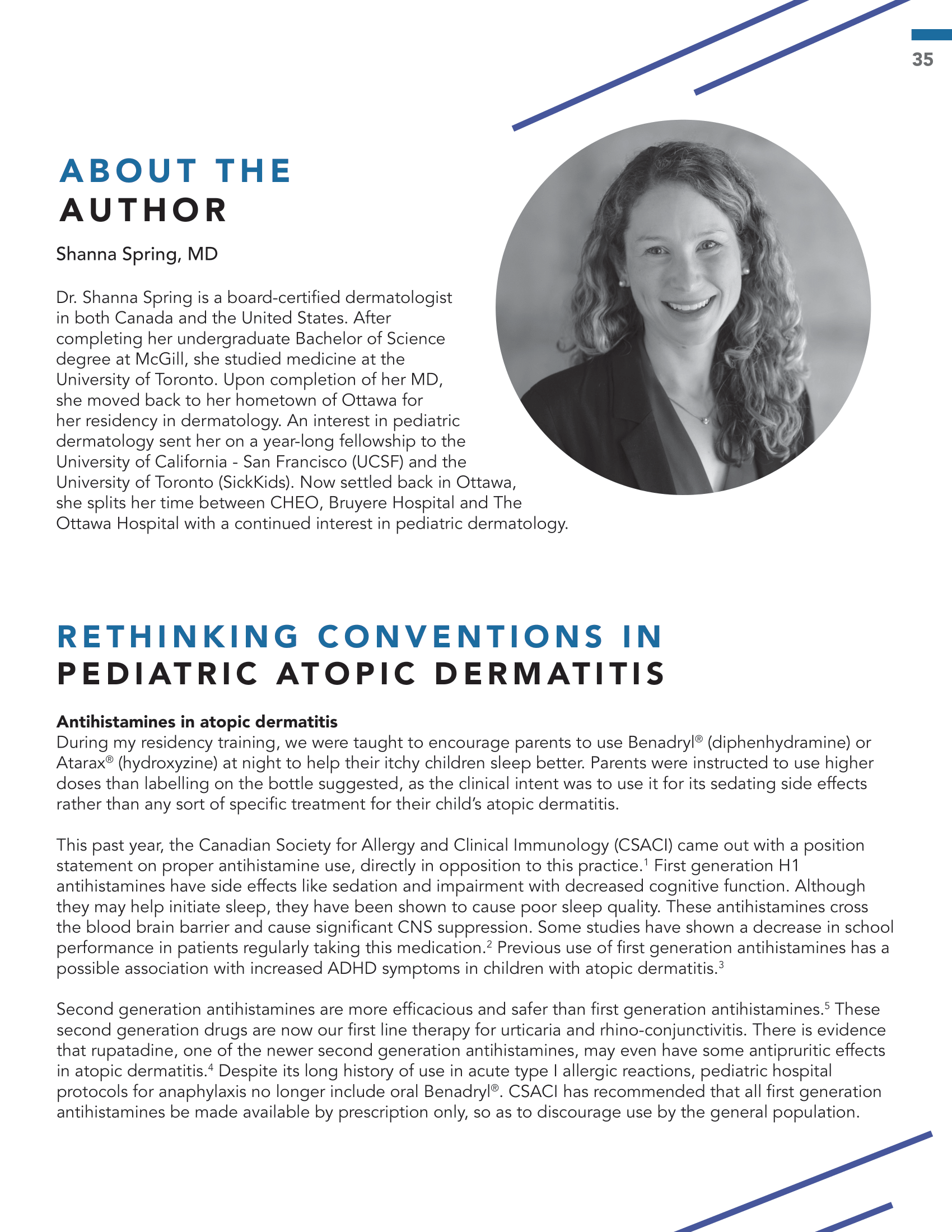Rethinking Conventions in Pediatric Atopic Dermatitis
Abstract
During my residency training, we were taught to encourage parents to use Benadryl® (diphenhydramine) or Atarax®(hydroxyzine) at night to help their itchy children sleep better. Parents were instructed to use higher doses than labelling on the bottle suggested, as the clinical intent was to use it for its sedating side effects rather than any sort of specific treatment for their child’s atopic dermatitis.
This past year, the Canadian Society for Allergy and Clinical Immunology (CSACI) came out with a position statement on proper antihistamine use, directly in opposition to this practice. First generation H1 antihistamines have side effects like sedation and impairment with decreased cognitive function. Although they may help initiate sleep, they have been shown to cause poor sleep quality. These antihistamines cross the blood brain barrier and cause significant CNS suppression. Some studies have shown a decrease in school performance in patients regularly taking this medication. Previous use of first generation antihistamines has a possible association with increased ADHD symptoms in children with atopic dermatitis.
References
Fein MN, Fischer DA, O’Keefe AW, Sussman GL. CSACI position statement: Newer generation H1-antihistamines are safer than first-generation H1-antihistamines and should be the first-line antihistamines for the treatment of allergic rhinitis and urticaria. Allergy, Asthma Clin Immunol. 2019;15(1):61. doi:10.1186/s13223-019-0375-9
Walker S, Khan-Wasti S, Fletcher M, Cullinan P, Harris J, Sheikh A. Seasonal allergic rhinitis is associated with a detrimental effect on examination performance in United Kingdom teenagers: Case-control study. J Allergy Clin Immunol. 2007;120(2):381-387. doi:10.1016/j.jaci.2007.03.034
Schmitt J, Buske-Kirschbaum A, Tesch F, et al. Increased attention-deficit/hyperactivity symptoms in atopic dermatitis are associated with history of antihistamine use. Allergy Eur J Allergy Clin Immunol. 2018;73(3):615-626. doi:10.1111/all.13326
Hide M, Suzuki T, Tanaka A, Aoki H. Long-term safety and efficacy of rupatadine in Japanese patients with itching due to chronic spontaneous urticaria, dermatitis, or pruritus: A 12-month, multicenter, open-label clinical trial. J Dermatol Sci. 2019;94(3):339-345. doi:10.1016/j.jdermsci.2019.05.008
Chopra R, Vakharia PP, Sacotte R, Silverberg JI. Efficacy of bleach baths in reducing severity of atopic dermatitis: A systematic review and meta-analysis. Ann Allergy Asthma Immunol. 2017;119(5):435-440. doi:10.1016/j.anai.2017.08.289
Bath-Hextall FJ, Birnie AJ, Ravenscroft JC, Williams HC. Interventions to reduce Staphylococcus aureus in the management of atopic eczema: An updated Cochrane review. Br J Dermatol. 2010;163(1):12-26. doi:10.1111/j.1365-2133.2010.09743.x
Sawada Y, Tong Y, Barangi M, et al. Dilute bleach baths used for treatment of atopic dermatitis are not antimicrobial in vitro. J Allergy Clin Immunol. 2019;143(5):1946-1948. doi:10.1016/j.jaci.2019.01.009
Majewski S, Bhattacharya T, Asztalos M, et al. Sodium hypochlorite body wash in the management of Staphylococcus aureus–colonized moderate-to-severe atopic dermatitis in infants, children, and adolescents. Pediatr Dermatol. 2019;36(4):442-447. doi:10.1111/pde.13842
Lansang P, Lara-Corrales I, Bergman JN, et al. Approach to the Assessment and Management of Pediatric Patients With Atopic Dermatitis: A Consensus Document. Section IV: Consensus Statements on the Assessment and Management of Pediatric Atopic Dermatitis. J Cutan Med Surg. 2019;23(5):32S-39S. doi:10.1177/1203475419882654
Simpson EL, Chalmers JR, Hanifin JM, et al. Emollient enhancement of the skin barrier from birth offers effective atopic dermatitis prevention. J Allergy Clin Immunol. 2014;134(4):818-823. doi:10.1016/j.jaci.2014.08.005
Horimukai K, Morita K, Narita M, et al. Application of moisturizer to neonates prevents development of atopic dermatitis. J Allergy Clin Immunol. 2014;134(4):824-830 e6. doi:10.1016/j.jaci.2014.07.060
Chalmers JR, Haines RH, Bradshaw LE, et al. Daily emollient during infancy for prevention of eczema: the BEEP randomised controlled trial. Lancet (London, England). 2020;6736(19). doi:10.1016/S0140-6736(19)32984-8
Skjerven HO, Rehbinder EM, Vettukattil R, et al. Skin emollient and early complementary feeding to prevent infant atopic dermatitis (PreventADALL): a factorial, multicentre, cluster-randomised trial. Lancet (London, England). 2020:1-11. doi:10.1016/S0140-6736(19)32983-6
Lowe A, Su J, Tang M, et al. PEBBLES study protocol: a randomised controlled trial to prevent atopic dermatitis, food allergy and sensitisation in infants with a family history of allergic disease using a skin barrier improvement strategy. doi:10.1136/bmjopen-2018-024594


